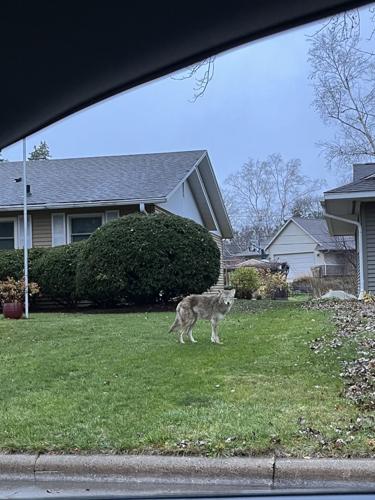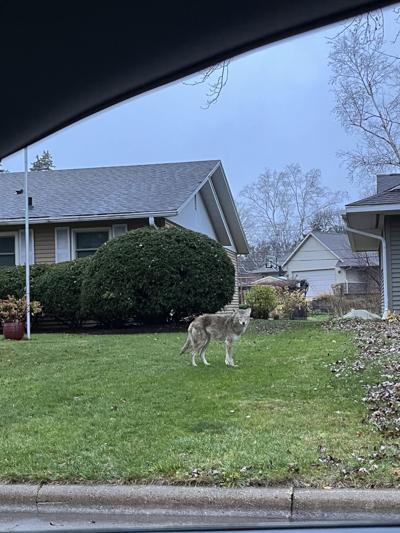In the past two weeks, at least one injured coyote seen plodding around the Midtown district has been the subject of more than 25 calls to Madison police. Officials want residents to haze the animal.
Sightings of one coyote have been reported in Vilas Park and the Nakoma neighborhood, where callers said that the animal seems to have an injured left front leg or foot, according to a statement from Madison police spokesperson Officer Stephanie Fryer.
The University of Wisconsin Canid Project, which studies coyotes and red foxes in the area, has also fielded calls about the coyote. In a post on the Project’s Facebook page Thursday, officials said they believe there are two coyotes roaming the West Side: The one with the leg injury and another with an unknown illness. Recent reports with the Project suggest that the animal with the leg injury might be moving better.
People are also reading…
Anyone who spots this coyote is encouraged to haze the creature by making loud noises, waving limbs or other objects, in order to maintain a healthy boundary between coyotes and humans.
“In order to maintain a positive coyote-human co-existence, it is important that healthy coyotes respect humans and move away from us when seen,” the Project’s Facebook post said. “Hazing will enforce and reinforce the fear of humans.”
The second coyote has been seen west of Midvale Boulevard and adjacent to Odana Hills Golf Course. Due to its sickness, this coyote should not be hazed, according to the Project.
In conjunction with the Wisconsin Department of Natural Resources, Madison Animal Control and the Dane County Humane Society’s Wildlife Center, the Project was attempting to trap the animal on Thursday and take it to the Wildlife Center for treatment.
PHOTOS: Madison's urban coyotes
Priscilla Lane

Mary Dwyer saw this coyote twice on Jan. 14 outside her Priscilla Lane home -- heading toward Hoyt Park around 8 a.m. and in the opposite direction about 12:30 p.m. She said she's seen three coyotes over the past several years. "I don’t know if their numbers are increasing or if they’re getting more used to human beings," she said.
Waunona Woods Court

Erin Ryan spotted this coyote "steps outside" her door at 20 Waunona Woods Court around 7 p.m. on Dec. 13. Ryan, who filmed the 30-second encounter on her phone, described it as "a pretty surreal experience."
Caldy Place

Dan and Gail Schaefer spotted this coyote near their home on Caldy Place in the Midvale Heights neighborhood over several cold days in mid-January. Researchers have tracked the coyote, which walks with a limp from an old injury to its right foreleg, across Madison's East and West sides and even into Verona.
Cottage Grove Road

In January 2020, after Chris Ondercin opened a panel to put insulation under the sunroom of his home on Cottage Grove Road, his dog began barking at the floor. A few seconds later this coyote emerged from the crawl space.
Highway D

A coyote eludes traffic while sprinting across County Highway D in the town of Fitchburg in this file photo from Nov. 12, 2018.
Odana Hills

A coyote sniffs as a pair of Sandhill cranes try to distract it from their nest in Odana Hills Park on May 10.
Waunona Way

Karl Lang shot this photo of a coyote feasting on a rabbit from the window of his home on Waunona Way. It's wearing a radio collar researchers use to track its movement.
UW Arboretum

A trail camera captured a coyote leaping across open water at the UW-Madison Arboretum in Januray 2020. The coyote is one of about two dozen animals equipped with tracking collars by the university's Urban Canid Project.
Open Wood Way

Sarah Schmeiser spotted this coyote traipsing through her nextdoor neighbor's yard on Sept. 7 near Heritage Heights Park on Madison's East Side. Schmeiser said the coyote turned the other way when her dog barked.
Waunona Way

Karl Lang, who shot this photo on Feb. 10 at his home on Waunona Way, said trail cameras on his property frequently catch coyotes but he doesn't usually see them during the day. The coyote is wearing a radio collar that UW-Madison researchers use to track the animal's movement.
Arctic Fox Drive

Barb Mulcahy spotted this coyote on May 31 outside her home on Arctic Fox Drive. In August she moved to a home next to the Hawk's Landing golf club, where she said she's had about half a dozen coyote sightings, usually around dusk.
Retana Street

One of two coyotes Linda Horvath spotted on Sept. 6 at her Retana Street home. "One first appeared from the greenway, and it walked a little ways, then another appeared watching the first one closely," Horvath said. "They were clearly together and possibly a male and female. The photos are just of the larger one, which I think was a male."
Thorstrand Road

Terry Lowe spotted a coyote walking along Thorstrand Road around 1 p.m. on Jan. 10. "I thought someone was walking their dog on a Sunday afternoon, until I got a better look," Lowe said.















